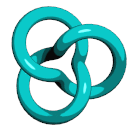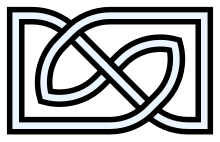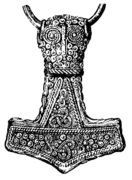| Revision as of 18:01, 25 March 2007 editAnonMoos (talk | contribs)Autopatrolled, Extended confirmed users, Pending changes reviewers71,966 edits →References: moving link from other article← Previous edit | Latest revision as of 01:45, 31 October 2024 edit undo2407:7000:9bcf:2377:e1f9:da6f:7325:5e96 (talk) →Symmetry: I added the statement that the object has rotational symmetry.Tag: Visual edit | ||
| (221 intermediate revisions by more than 100 users not shown) | |||
| Line 1: | Line 1: | ||
| {{Short description|Simplest non-trivial closed knot with three crossings}} | |||
| {{otheruses4|the topological concept|the protein fold|trefoil knot fold}} | |||
| {{About|the topological concept|the protein fold|trefoil knot fold}} | |||
| <!--{{unreferenced|date=June 2006}}--> | |||
| {{Infobox knot theory | |||
| | name= Trefoil | |||
| | practical name= Overhand knot|Overhand | |||
| | image= Blue Trefoil Knot Animated.gif | |||
| | caption= | |||
| | arf invariant= 1 | |||
| | braid length= 3 | |||
| | braid number= 2 | |||
| | bridge number= 2 | |||
| | crosscap number= 1 | |||
| | crossing number= 3 | |||
| | genus= 1 | |||
| | hyperbolic volume= 0 | |||
| | linking number= | |||
| | stick number= 6 | |||
| | unknotting number= 1 | |||
| | tunnel number= 1 | |||
| | conway_notation= | |||
| | ab_notation= 3<sub>1</sub> | |||
| | dowker notation= 4, 6, 2 | |||
| | thistlethwaite= | |||
| | last crossing= 0 | |||
| | last order= 1 | |||
| | next crossing= 4 | |||
| | next order= 1 | |||
| | alternating= alternating | |||
| | class= torus | |||
| | fibered= fibered | |||
| | pretzel= pretzel | |||
| | prime= prime | |||
| | slice= knot slice | |||
| | symmetry= reversible | |||
| | tricolorable= tricolorable | |||
| | twist= twist | |||
| }} | |||
| In ], a branch of ], the '''trefoil knot''' is the simplest example of a nontrivial ]. The trefoil can be obtained by joining the two loose ends of a common ], resulting in a knotted ]. As the simplest knot, the trefoil is fundamental to the study of mathematical knot theory. | |||
| The trefoil knot is named after the three-leaf ] (or trefoil) plant. | |||
| ] | |||
| ] | |||
| In ], the '''trefoil knot''' is the simplest nontrivial ]. | |||
| == |
== Descriptions == | ||
| The trefoil knot can be defined as the ] obtained from the following ]s: | |||
| :<math>\begin{align} | |||
| *It can be described as a (2,3)-]. | |||
| x &= \sin t + 2 \sin 2t \\ | |||
| *It is the closure of the braid σ<sub>1</sub><sup>3</sup>. | |||
| y &= \cos t - 2 \cos 2t \\ | |||
| *It is the intersection of the unit ] <math>S^3</math> in '''C'''<sup>2</sup> with the ] (a ]) of zeroes of the complex ] <math>z^2+w^3</math>. | |||
| z &= -\sin 3t | |||
| \end{align}</math> | |||
| The (2,3)-] is also a trefoil knot. The following parametric equations give a (2,3)-torus knot lying on ] <math>(r-2)^2+z^2 = 1</math>: | |||
| ===Properties=== | |||
| :<math>\begin{align} | |||
| *It is the unique ] with three ]. | |||
| x &= (2+\cos 3t) \cos 2t \\ | |||
| *It is ], meaning it is not equivalent to its ]. | |||
| y &= (2+\cos 3t )\sin 2t \\ | |||
| *It is ]. | |||
| z &= \sin 3t | |||
| *It is not a ], meaning that it does not bound a smooth 2-dimensional disk in the 4-dimensional ball; one way to prove this is to note that its ] is not zero. | |||
| \end{align}</math> | |||
| *It is a ], meaning that its ] in <math>S^3</math> is a ] over the ] <math>S^1</math>. In the model of the trefoil as the set of pairs <math>(z,w)</math> of complex numbers such that <math>|z|^2+|w|^2=1</math> and <math>z^2+w^3=0</math>, this ] has the ] <math>\phi(z,w)=(z^2+w^3)/|z^2+w^3|</math> as its ], and a once-punctured ] as its ]. | |||
| ] | |||
| ] | |||
| ] | |||
| Any continuous deformation of the curve above is also considered a trefoil knot. Specifically, any curve ] to a trefoil knot is also considered to be a trefoil. In addition, the ] of a trefoil knot is also considered to be a trefoil. In topology and knot theory, the trefoil is usually defined using a ] instead of an explicit parametric equation. | |||
| ===Invariants=== | |||
| *Its ] is <math>t^2-t+1</math>. | |||
| *Its ] is <math>t+t^3-t^4</math>. | |||
| *Its ] is ] to ''B''<sub>3</sub>, the ] on 3 strands, which has ] <math>\langle x,y \mid x^2 = y^3 \rangle\,</math> or <math>\langle \sigma_1,\sigma_2 \mid \sigma_1\sigma_2\sigma_1 = \sigma_2\sigma_1\sigma_2 \rangle.\,</math> | |||
| In ], the trefoil can also be obtained as the intersection in '''C'''<sup>2</sup> of the unit ] ''S''<sup>3</sup> with the ] of zeroes of the complex ] ''z''<sup>2</sup> + ''w''<sup>3</sup> (a ]). | |||
| ==See also== | |||
| *] | |||
| *] | |||
| {{multiple image | |||
| ==References== | |||
| | width = 150 | |||
| * ] (1976). ''Knots and links''. ]: Publish or Perish, Inc. ISBN 0-914098-16-0. | |||
| | footer = A left-handed trefoil and a right-handed trefoil. | |||
| * {{mathworld|urlname=TrefoilKnot|title=Trefoil Knot}} | |||
| | image1 = Trefoil knot left.svg | |||
| | alt1 = Left-handed trefoil | |||
| | image2 = TrefoilKnot 01.svg | |||
| | alt2 = Right-handed trefoil | |||
| }} | |||
| If one end of a tape or belt is turned over three times and then pasted to the other, the edge forms a trefoil knot.<ref>Shaw, George Russell ({{Roman|1933}}). ''Knots: Useful & Ornamental'', p.11. {{isbn|978-0-517-46000-9}}.</ref> | |||
| ==External link== | |||
| * | |||
| == Symmetry == | |||
| ] | |||
| The trefoil knot is ], in the sense that a trefoil knot can be distinguished from its own mirror image. The two resulting variants are known as the '''left-handed trefoil''' and the '''right-handed trefoil'''. It is not possible to deform a left-handed trefoil continuously into a right-handed trefoil, or vice versa. (That is, the two trefoils are not ].) | |||
| Though chiral, the trefoil knot is also invertible, meaning that there is no distinction between a ]-oriented and a clockwise-oriented trefoil. That is, the chirality of a trefoil depends only on the over and under crossings, not the orientation of the curve. | |||
| ] | |||
| ] | |||
| But the knot has rotational symmetry. The axis is about a line perpendicular to the page for the 3-coloured image. | |||
| ] | |||
| ].]] | |||
| ] | |||
| == Nontriviality == | |||
| The trefoil knot is nontrivial, meaning that it is not possible to "untie" a trefoil knot in three dimensions without cutting it. Mathematically, this means that a trefoil knot is not isotopic to the ]. In particular, there is no sequence of ]s that will untie a trefoil. | |||
| Proving this requires the construction of a ] that distinguishes the trefoil from the unknot. The simplest such invariant is ]: the trefoil is tricolorable, but the unknot is not. In addition, virtually every major ] distinguishes the trefoil from an unknot, as do most other strong knot invariants. | |||
| == Classification == | |||
| In knot theory, the trefoil is the first nontrivial knot, and is the only knot with ] three. It is a ], and is listed as 3<sub>1</sub> in the ]. The ] for the trefoil is 4 6 2, and the ] is . | |||
| The trefoil can be described as the (2,3)-]. It is also the knot obtained by closing the ] σ<sub>1</sub><sup>3</sup>. | |||
| The trefoil is an ]. However, it is not a ], meaning it does not bound a smooth 2-dimensional disk in the 4-dimensional ball; one way to prove this is to note that its ] is not zero. Another proof is that its Alexander polynomial does not satisfy the ]. | |||
| The trefoil is a ], meaning that its ] in <math>S^3</math> is a ] over the ] <math>S^1</math>. The trefoil '''K''' may be viewed as the set of pairs <math>(z,w)</math> of ]s such that <math>|z|^2+|w|^2=1</math> and <math>z^2+w^3=0</math>. Then this ] has the ] <math>\phi(z, w) = (z^2+w^3) / |z^2+w^3|</math> as the fibre bundle projection of the knot complement <math>S^3 \setminus \mathbf{K}</math> to the circle <math>S^1</math>. The fibre is a ] ]. Since the knot complement is also a ] with boundary, it has a horizontal incompressible surface—this is also the fiber of the ]. (This assumes the knot has been thickened to become a solid torus N<sub>ε</sub>('''K'''), and that the interior of this solid torus has been removed to create a compact knot complement <math>S^3 \setminus \operatorname{int}(\mathrm{N}_\varepsilon(\mathbf{K})</math>.) | |||
| == Invariants == | |||
| The ] of the trefoil knot is | |||
| <math display="block">\Delta(t) = t - 1 + t^{-1}, </math> | |||
| and the ] is<ref>{{Knot Atlas|3_1}}</ref> | |||
| <math display="block">\nabla(z) = z^2 + 1.</math> | |||
| The ] is | |||
| <math display="block">V(q) = q^{-1} + q^{-3} - q^{-4}, </math> | |||
| and the ] of the trefoil is | |||
| <math display="block">L(a,z) = za^5 + z^2a^4 - a^4 + za^3 + z^2a^2-2a^2. </math> | |||
| The ] of the trefoil is | |||
| <math display="block">L(\alpha,z) = -\alpha^4 + \alpha^2z^2 + 2\alpha^2. </math> | |||
| The ] of the trefoil is given by the presentation | |||
| <math display="block">\langle x,y \mid x^2=y^3 \rangle </math> | |||
| or equivalently<ref>{{MathWorld|title=Trefoil Knot|id=TrefoilKnot}} Accessed: May 5, 2013.</ref> | |||
| <math display="block">\langle x,y \mid xyx=yxy \rangle. </math> | |||
| This group is isomorphic to the ] with three strands. | |||
| == In religion and culture == | |||
| As the simplest nontrivial knot, the trefoil is a common ] in ] and the ]. For example, the common form of the ] symbol is a trefoil, as are some versions of the Germanic ]. | |||
| {{Gallery | |||
| |File:Mjollnir.png|An ancient Norse ] pendant with trefoils | |||
| |File:Triquetra-Vesica.svg|A simple ] symbol | |||
| |File:Triquetra-tightly-knotted.svg|A tightly-knotted triquetra | |||
| |File:Valknut-Symbol-triquetra.svg|The Germanic ] | |||
| |File:Metallic Valknut black background.PNG|A metallic Valknut in the shape of a trefoil | |||
| |File:Cruz_Celta_con_Trisquetas.svg|A ] with trefoil knots | |||
| |File:Triquetra-Cross.svg|A ] | |||
| |File:ATV News GL5463 left side 20060712.jpg|Trefoil knot used in ]'s logo | |||
| |File:Superfície não orientável - Bordo trifólio.jpg|Mathematical surface in which the boundary is the trefoil knot in different angles. | |||
| }} | |||
| In modern art, the woodcut ''Knots'' by ] depicts three trefoil knots whose solid forms are twisted in different ways.<ref></ref> | |||
| == See also == | |||
| {{commons category|Trefoil knots}} | |||
| * ] | |||
| * ] | |||
| * ] symbol | |||
| * ] | |||
| * ] | |||
| == References == | |||
| {{reflist | 30em}} | |||
| == External links == | |||
| * | |||
| * | |||
| {{Knot theory|state=collapsed}} | |||
Latest revision as of 01:45, 31 October 2024
Simplest non-trivial closed knot with three crossings This article is about the topological concept. For the protein fold, see trefoil knot fold.In knot theory, a branch of mathematics, the trefoil knot is the simplest example of a nontrivial knot. The trefoil can be obtained by joining the two loose ends of a common overhand knot, resulting in a knotted loop. As the simplest knot, the trefoil is fundamental to the study of mathematical knot theory.
The trefoil knot is named after the three-leaf clover (or trefoil) plant.
Descriptions
The trefoil knot can be defined as the curve obtained from the following parametric equations:
The (2,3)-torus knot is also a trefoil knot. The following parametric equations give a (2,3)-torus knot lying on torus :


Any continuous deformation of the curve above is also considered a trefoil knot. Specifically, any curve isotopic to a trefoil knot is also considered to be a trefoil. In addition, the mirror image of a trefoil knot is also considered to be a trefoil. In topology and knot theory, the trefoil is usually defined using a knot diagram instead of an explicit parametric equation.
In algebraic geometry, the trefoil can also be obtained as the intersection in C of the unit 3-sphere S with the complex plane curve of zeroes of the complex polynomial z + w (a cuspidal cubic).

 A left-handed trefoil and a right-handed trefoil.
A left-handed trefoil and a right-handed trefoil.
If one end of a tape or belt is turned over three times and then pasted to the other, the edge forms a trefoil knot.
Symmetry
The trefoil knot is chiral, in the sense that a trefoil knot can be distinguished from its own mirror image. The two resulting variants are known as the left-handed trefoil and the right-handed trefoil. It is not possible to deform a left-handed trefoil continuously into a right-handed trefoil, or vice versa. (That is, the two trefoils are not ambient isotopic.)
Though chiral, the trefoil knot is also invertible, meaning that there is no distinction between a counterclockwise-oriented and a clockwise-oriented trefoil. That is, the chirality of a trefoil depends only on the over and under crossings, not the orientation of the curve.
But the knot has rotational symmetry. The axis is about a line perpendicular to the page for the 3-coloured image.


Nontriviality
The trefoil knot is nontrivial, meaning that it is not possible to "untie" a trefoil knot in three dimensions without cutting it. Mathematically, this means that a trefoil knot is not isotopic to the unknot. In particular, there is no sequence of Reidemeister moves that will untie a trefoil.
Proving this requires the construction of a knot invariant that distinguishes the trefoil from the unknot. The simplest such invariant is tricolorability: the trefoil is tricolorable, but the unknot is not. In addition, virtually every major knot polynomial distinguishes the trefoil from an unknot, as do most other strong knot invariants.
Classification
In knot theory, the trefoil is the first nontrivial knot, and is the only knot with crossing number three. It is a prime knot, and is listed as 31 in the Alexander-Briggs notation. The Dowker notation for the trefoil is 4 6 2, and the Conway notation is .
The trefoil can be described as the (2,3)-torus knot. It is also the knot obtained by closing the braid σ1.
The trefoil is an alternating knot. However, it is not a slice knot, meaning it does not bound a smooth 2-dimensional disk in the 4-dimensional ball; one way to prove this is to note that its signature is not zero. Another proof is that its Alexander polynomial does not satisfy the Fox-Milnor condition.
The trefoil is a fibered knot, meaning that its complement in is a fiber bundle over the circle . The trefoil K may be viewed as the set of pairs of complex numbers such that and . Then this fiber bundle has the Milnor map as the fibre bundle projection of the knot complement to the circle . The fibre is a once-punctured torus. Since the knot complement is also a Seifert fibred with boundary, it has a horizontal incompressible surface—this is also the fiber of the Milnor map. (This assumes the knot has been thickened to become a solid torus Nε(K), and that the interior of this solid torus has been removed to create a compact knot complement .)
Invariants
The Alexander polynomial of the trefoil knot is and the Conway polynomial is The Jones polynomial is and the Kauffman polynomial of the trefoil is The HOMFLY polynomial of the trefoil is The knot group of the trefoil is given by the presentation or equivalently This group is isomorphic to the braid group with three strands.
In religion and culture
As the simplest nontrivial knot, the trefoil is a common motif in iconography and the visual arts. For example, the common form of the triquetra symbol is a trefoil, as are some versions of the Germanic Valknut.
-
 An ancient Norse Mjöllnir pendant with trefoils
An ancient Norse Mjöllnir pendant with trefoils
-
 A simple triquetra symbol
A simple triquetra symbol
-
 A tightly-knotted triquetra
A tightly-knotted triquetra
-
 The Germanic Valknut
The Germanic Valknut
-
A metallic Valknut in the shape of a trefoil
-
 A Celtic cross with trefoil knots
A Celtic cross with trefoil knots
-
 A Carolingian cross
A Carolingian cross
- [REDACTED] Trefoil knot used in ATV's logo
-
 Mathematical surface in which the boundary is the trefoil knot in different angles.
Mathematical surface in which the boundary is the trefoil knot in different angles.
In modern art, the woodcut Knots by M. C. Escher depicts three trefoil knots whose solid forms are twisted in different ways.
See also
References
- Shaw, George Russell (MCMXXXIII). Knots: Useful & Ornamental, p.11. ISBN 978-0-517-46000-9.
- "3_1", The Knot Atlas.
- Weisstein, Eric W. "Trefoil Knot". MathWorld. Accessed: May 5, 2013.
- The Official M.C. Escher Website — Gallery — "Knots"
External links
| Knot theory (knots and links) | |
|---|---|
| Hyperbolic |
|
| Satellite | |
| Torus | |
| Invariants | |
| Notation and operations | |
| Other | |


 :
:

 is a
is a  . The trefoil K may be viewed as the set of pairs
. The trefoil K may be viewed as the set of pairs  of
of  and
and  . Then this
. Then this  as the fibre bundle projection of the knot complement
as the fibre bundle projection of the knot complement  to the circle
to the circle  .)
.)
 and the
and the  The
The  and the
and the  The
The  The
The  or equivalently
or equivalently
 This group is isomorphic to the
This group is isomorphic to the